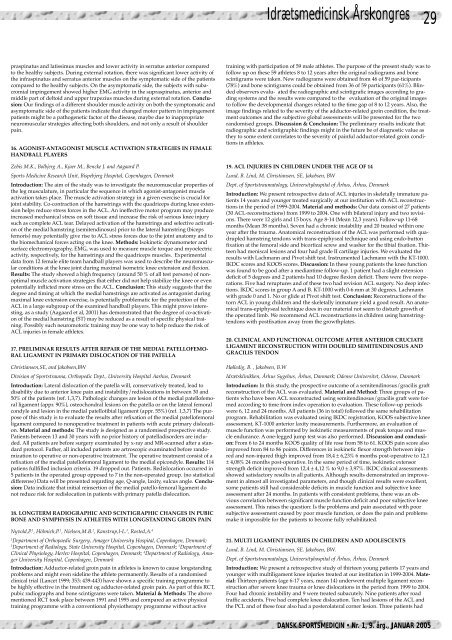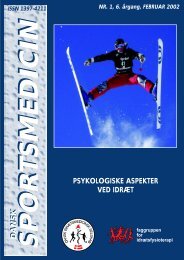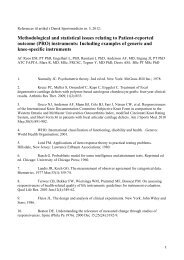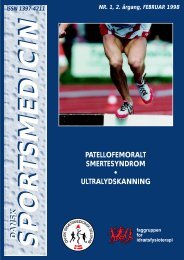Nr. 1/05 samlet - Dansk Sportsmedicin
Nr. 1/05 samlet - Dansk Sportsmedicin
Nr. 1/05 samlet - Dansk Sportsmedicin
You also want an ePaper? Increase the reach of your titles
YUMPU automatically turns print PDFs into web optimized ePapers that Google loves.
praspinatus and latissimus muscles and lower activity in serratus anterior compared<br />
to the healthy subjects. During external rotation, there was significant lower activity of<br />
the infraspinatus and serratus anterior muscles on the symptomatic side of the patients<br />
compared to the healthy subjects. On the asymptomatic side, the subjects with subacromial<br />
impingement showed higher EMG activity in the supraspinatus, anterior and<br />
middle part of deltoid and upper trapezius muscles during external rotation. Conclusion:<br />
Our findings of a different shoulder muscle activity on both the symptomatic and<br />
asymptomatic side of the patients indicate that changed motor pattern in impingement<br />
patients might be a pathogenetic factor of the disease, maybe due to inappropriate<br />
neuromuscular strategies affecting both shoulders, and not only a result of shoulder<br />
pain.<br />
16. AGONIST-ANTAGONIST MUSCLE ACTIVATION STRATEGIES IN FEMALE<br />
HANDBALL PLAYERS<br />
Zebis M.K., Bolbjerg A., Kjaer M., Bencke J. and Aagaard P.<br />
Sports Medicine Research Unit, Bispebjerg Hospital, Copenhagen, Denmark<br />
Introduction: The aim of the study was to investigate the neuromuscular properties of<br />
the leg musculature, in particular the sequence in which agonist-antagonist muscle<br />
activation takes place. The muscle activation strategy in a given exercise is crucial for<br />
joint stability. Co-contraction of the hamstrings with the quadriceps during knee extension<br />
helps reduce stress forces in the ACL. An ineffective motor program may produce<br />
increased mechanical stress on soft tissue and increase the risk of serious knee injury<br />
such as complete ACL tear. Delayed activation of the hamstrings and selective activation<br />
of the medial hamstring (semitendinosus) prior to the lateral hamstring (biceps<br />
femoris) may potentially give rise to ACL stress forces due to the joint anatomy and to<br />
the biomechanical forces acting on the knee. Methods: Isokinetic dynamometer and<br />
surface electromyography, EMG, was used to measure muscle torque and myoelectric<br />
activity, respectively, for the hamstrings and the quadriceps muscles. Experimental<br />
data from 12 female elite team handball players was used to describe the neuromuscular<br />
conditions at the knee joint during maximal isometric knee extension and flexion.<br />
Results: The study showed a high frequency (around 50 % of all test persons) of nonoptimal<br />
muscle activation strategies that either did not help stabilize the knee or even<br />
potentially inflicted more stress on the ACL. Conclusion: This study suggests that the<br />
degree and timing at which the medial hamstrings are activated as antagonist during<br />
maximal knee extension exercise, is potentially problematic for the protection of the<br />
ACL in a large subgroup of the examined handball players. This might prove interesting,<br />
as a study (Aagaard et al, 2001) has demonstrated that the degree of co-activation<br />
of the medial hamstring (ST) may be reduced as a result of specific physical training.<br />
Possibly such neuromotoric training may be one way to help reduce the risk of<br />
ACL injuries in female athletes.<br />
17. PRELIMINAR RESULTS AFTER REPAIR OF THE MEDIAL PATELLOFEMO-<br />
RAL LIGAMENT IN PRIMARY DISLOCATION OF THE PATELLA<br />
Christiansen,SE, and Jakobsen,BW<br />
Division of Sportstrauma, Orthopedic Dept., University Hospital Aarhus, Denmark<br />
Introduction: Lateral dislocation of the patella will, conservatively treated, lead to<br />
disability due to anterior knee pain and instability/redislocations in between 30 and<br />
50% of the patients (ref. 1,3,7). Pathologic changes are lesion of the medial patellofemoral<br />
ligament (appr. 90%), osteochondral lesions on the patella or on the lateral femoral<br />
condyle and lesion in the medial patellotibial ligament (appr. 55%) (ref. 1,3,7) The purpose<br />
of this study is to evaluate the results after refixation of the medial patellofemoral<br />
ligament compared to nonoperative treatment in patients with acute primary dislocation.<br />
Material and methods: The study is designed as a randomised prospective study.<br />
Patients between 13 and 30 years with no prior history of patelladisorders are included.<br />
All patients are before surgery examinated by x-ray and MR-scanned after a standard<br />
protocol. Futher, all included patients are artroscopic examinated before randomization<br />
to operative or non-operative treatment. The operative treatment consist of a<br />
refixation of the medial patellofemoral ligament to the medial epicondyle. Results: 114<br />
patiens fullfilled inclusion criteria. 19 dropped out. Patients. Redislocation occurred in<br />
5 patients in the operated group opposed to 7 in the non-operated group. (no statistical<br />
differense) Data will be presented regarding age, Q-angle, laxity, sulcus angle. Conclusion:<br />
Data indicate that initial reinsertion of the medial patello-femoral ligament do<br />
not reduce risk for redislocation in patients with primary patella dislocation.<br />
18. LONGTERM RADIOGRAPHIC AND SCINTIGRAPHIC CHANGES IN PUBIC<br />
BONE AND SYMPHYSIS IN ATHLETES WITH LONGSTANDING GROIN PAIN<br />
Nyvold,P. 1 , Hölmich,P. 1 , Nielsen,M.B. 2 , Kanstrup,I-L. 3 , Rosted,A. 4<br />
1Department of Orthopaedic Surgery, Amager University Hospital, Copenhagen, Denmark;<br />
2 3 Department of Radiology, State University Hospital, Copenhagen, Denmark; Department of<br />
Clinical Physiology, Herlev Hospital, Copenhagen, Denmark; 4Department of Radiology, Amager<br />
University Hospital, Copenhagen, Denmark<br />
Introduction: Adductor-related groin pain in athletes is known to cause longstanding<br />
problems and might even sideline the athlete permanently. Results of a randomised<br />
clinical trial (Lancet 1999; 353: 439-443) have shown a specific training programme to<br />
be highly effective in the treatment og adductor-related groin pain. As part of this RCT,<br />
pubic radiographs and bone scintigrams were taken. Material & Methods: The above<br />
mentioned RCT took place between 1991 and 1995 and compared an active physical<br />
training programme with a conventional physiotherapy programme without active<br />
Idrætsmedicinsk Årskongres 29<br />
training with participation of 59 male athletes. The purpose of the present study was to<br />
follow up on these 59 athletes 8 to 12 years after the original radiograms and bone<br />
scintigrams were taken. New radiograms were obtained from 46 of 59 par-ticipants<br />
(78%) and bone scintigrams could be obtained from 36 of 59 participants (61%). Blinded<br />
observers evalu- ated the radiographic and scintigrafic images according to grading<br />
systems and the results were compared to the evaluation of the original images<br />
to follow the developmental changes related to the time gap of 8 to 12 years. Also, the<br />
image findings related to the severity of the adductor-related groin condition, the treatment<br />
outcomes and the subjective global assessments will be presented for the two<br />
randomised groups. Discussion & Conclusion: The preliminary results indicate that<br />
radiographic and scintigraphic findings might in the future be of diagnostic value as<br />
they to some extent correlates to the severity of painful adductor-related groin conditions<br />
in athletes.<br />
19. ACL INJURIES IN CHILDREN UNDER THE AGE OF 14<br />
Lund, B. Lind, M. Christiansen, SE. Jakobsen, BW<br />
Dept. of Sportstraumatology, Universityhospital of Århus, Århus, Denmark<br />
Introduction: We present retrospective data of ACL injuries in skeletally immature patients<br />
14 years and younger treated surgically at our institution with ACL reconstructions<br />
in the period of 1999-2004. Material and methods: Our data consist of 27 patients<br />
(30 ACL-reconstructions) from 1999 to 2004. One with bilateral injury and two revisions.<br />
There were 12 girls and 15 boys. Age 8-14 (Mean 12,3 years). Follow-up 11-68<br />
months (Mean 38 months). Seven had a chronic instability and 20 treated within one<br />
year after the trauma. Anatomical reconstruction of the ACL was performed with quadrupled<br />
hamstring tendons with trans-epiphyseal technique and using endo-button<br />
fixation at the femoral side and bicortical screw and washer for the tibial fixation. Thirteen<br />
had meniscal lesions and four had grade II cartilage injuries. We evaluated the<br />
results with Lachmann and Pivot shift test. Instrumented Lachmann with the KT-1000.<br />
IKDC scores and KOOS scores. Discussion: In these young patients the knee function<br />
was found to be good after a mediantime follow-up. 1 patient had a slight extension<br />
deficit of 5 degrees and 2 patients had 10 degree flexion deficit. There were five reoperations.<br />
Five had reruptures and of these two had revision ACL surgery. No deep infections.<br />
IKDC scores in group A and B. KT-1000 with 0-6 mm at 30 degrees. Lachmann<br />
with grade 0 and 1. No or glide at Pivot shift test. Conclusion: Reconstructions of the<br />
torn ACL in young children and the skeletally immature yield a good result. An anatomical<br />
trans-epiphyseal technique does in our material not seem to disturb growth of<br />
the operated limb. We recommend ACL reconstructions in children using hamstringtendons<br />
with postfixation away from the growthplates.<br />
20. CLINICAL AND FUNCTIONAL OUTCOME AFTER ANTERIOR CRUCIATE<br />
LIGAMENT RECONSTRUCTION WITH DOUBLED SEMITENDINOSUS AND<br />
GRACILIS TENDON<br />
Hølledig, B. , Jakobsen, B.W<br />
Idrætsklinikken, Århus Sygehus, Århus, Danmark; Odense Universitet, Odense, Danmark<br />
Introduction: In this study, the prospective outcome of a semitendinosus/gracilis graft<br />
reconstruction of the ACL was evaluated. Material and Method: Three groups of patients<br />
who have been ACL reconstructed using semitendinosus/gracilis graft were formed<br />
according to time from index operation to evaluation. These follow-up periods<br />
were 6, 12 and 24 months. All patients (36 in total) followed the same rehabilitation<br />
program. Rehabilitation was evaluated using IKDC registration, KOOS subjective knee<br />
assessment, KT-1000 anterior laxity measurements. Furthermore, an evaluation of<br />
muscle function was performed by isokinetic measurements of peak torque and muscle<br />
endurance. A one-legged jump test was also performed. Discussion and conclusion:<br />
From 6 to 24 months KOOS quality of life rose from 58 to 61. KOOS pain score also<br />
improved from 84 to 86 points. Differences in isokinetic flexor strength between injured<br />
and non-injured thigh improved from 18,4 ± 6,23% 6 months post-operative to 12,1<br />
± 4,08% 24 months post-operative. In the same period of time, isokinetic extensor<br />
strength deficit improved from 12,4 ± 4,12 % to 9,0 ± 3,97%. IKDC clinical assessments<br />
showed satisfactory results in all patients. Although results demonstrated an improvement<br />
in almost all investigated parameters, and though clinical results were excellent,<br />
some patients still had considerable deficits in muscle function and subjective knee<br />
assessment after 24 months. In patients with consistent problems, there was an obvious<br />
correlation between significant muscle function deficit and poor subjective knee<br />
assessment. This raises the question: Is the problems and pain associated with poor<br />
subjective assessment caused by poor muscle function, or does the pain and problems<br />
make it impossible for the patients to become fully rehabilitated.<br />
21. MULTI LIGAMENT INJURIES IN CHILDREN AND ADOLESCENTS<br />
Lund, B. Lind, M. Christiansen, SE. Jakobsen, BW.<br />
Dept. of Sportstraumatology, Universityhospital of Århus, Århus, Denmark<br />
Introduction: We present a retrospective study of thirteen young patients 17 years and<br />
younger with multiligament knee injuries treated at our institution in 1999-2004. Material:<br />
Thirteen patients (age 6-17 years, mean 14) underwent multiple ligament reconstruction<br />
after severe knee trauma or knee dislocations in the period from 1999 to 2004.<br />
Four had chronic instability and 9 were treated subacutely. Nine patients after road<br />
traffic accidents. Five had complete knee dislocation. Ten had lesions of the ACL and<br />
the PCL and of these four also had a posterolateral corner lesion. Three patients had<br />
DANSK SPORTSMEDICIN • <strong>Nr</strong>. 1, 9. årg., JANUAR 20<strong>05</strong>















